
The weather in Berlin looked iffy, but after nearly an hour on the train to Oranienburg, the sun was shining and the sky was a clear and beautiful blue. Foregoing the bus, we had a nice stroll of about 1.5 miles through quiet suburban streets.
We later learned that prisoners bound for the concentration camp at Sachsenhausen sometimes arrived by more or less the same route, taking a public train from Berlin to Oranienburg where they were paraded through the streets. Residents of the town were encouraged to shout and throw stones.
I stepped off of the sidewalk to make way for an old woman on a bike. As she passed, she gave me a merry “Danke schön!” It was the friendliest interaction we’d had with a random German on the street, most of whom seemed brusque and withdrawn. At the end of the block she dismounted and walked into a house directly across the street from the entrance to the concentration camp cum museum and memorial. How does anyone, let alone some so cheery, live across the street from such a place?
Finding the idea of picnicking in a concentration camp odd, Emily and I sat on a bench at a bus stop just outside and ate the sandwiches we’d purchased at the train station. It turns out that one of the old camp administration buildings is now a cafe, but we weren’t expecting any food to be available inside.
 The beautiful weather seemed inappropriate for the place, which is perhaps why I never felt the sense of sheer horror that I expected Sachsenhausen to exude. Many of the original buildings had been demolished as part of a misguided attempt by the GDR (the East German government) to memorialize the camp. Even walking through the execution pit, seeing bullet holes in the wooden embankments, the hooks from which men were hung, and the rusted remains of the cremation furnaces (for the dead only, as far as I know – no indication of anyone burned alive here) was only mildly eerie. The evil of the place felt long ago and far away.
The beautiful weather seemed inappropriate for the place, which is perhaps why I never felt the sense of sheer horror that I expected Sachsenhausen to exude. Many of the original buildings had been demolished as part of a misguided attempt by the GDR (the East German government) to memorialize the camp. Even walking through the execution pit, seeing bullet holes in the wooden embankments, the hooks from which men were hung, and the rusted remains of the cremation furnaces (for the dead only, as far as I know – no indication of anyone burned alive here) was only mildly eerie. The evil of the place felt long ago and far away.
It didn’t help that the audio guide, acquired for three euros in the visitor’s center from a young woman sporting multiple piercings on her face and a low-cut shirt, was so rambling and disorganized. The museum’s current incarnation is relatively young, and much of the audio guide hints at the self-serving nature of the old GDR memorial and at future plans for the museum. After a while we started to get a sense of the political/bureaucratic backstory that might be driving some of this content. In any event, the result was a garbled presentation that failed to drive home the horror of the place.
Nonetheless, I came away from Sachsenhausen with a new appreciation for a few things that I’d only vaguely understood before. At least in the early days of the concentration camps, the Schutztaffel (or SS – the Nazi’s elite paramilitary organization) were apparently to some extent operating “rogue”, ie doing things of which other parts of the Nazi government did not approve. Thus they sometimes had to make murders look like suicides or escape attempts. I’d always thought they were hiding their crimes primarily from the outside world or the judgment of the future, but in one case a camp leader was actually sentenced to a year in prison by a Nazi judge because of the execution of a prisoner.
Consequently there’s a lot that still isn’t known about what exactly happened here. Who was in the camp? Why? What happened to them?
Much of what we do know is owing only to the courage and foresight of extraordinary people. One prisoner, ordered to photograph 10,000 Soviet POWs who were subsequently executed, saved the negatives and smuggled them out of the camp. Others collected and counted the dog tags bearing the POWs’ names. Without these efforts at documentation, the Nazis might have succeeded in hiding their crimes. Probably in some cases they did. It was only in 1996 that large deposits of human ashes were discovered at Sachsenhausen, mixed into the material with which the roads were paved.
In some ways it seems like extraneous information: what moral difference does it make if 60,000 or 70,000 died? If they were shot rather than simply starved or worked to death? Yet these things do make a difference, for there are still perpetrators alive to punish (young men were deliberately hired as guards for the camp because they could be more easily socialized into the depraved culture of the SS) and victims to compensate, when specific crimes can be proven.
The Holocaust was about dehumanization, about treating people as an indistinguishable mass. Now there is a need to undo this, to determine exactly what happened to each and every individual there as a way of affirming the value of that person’s life.

“The Holocaust was about dehumanization, about treating people as an indistinguishable mass. Now there is a need to undo this”
I suspect that most Germans will not agree with your conclusion.
They will not say but they think that NOW there is a need to forget about Holocaust.
I suspect that most American scholars will not agree with you too.
Their definition of Holocaust is much more exclusive.
Their definition does not include the genocide of Soviet POWs,Gypsies,Polish and Russian civilians,political and religious opponents,etc.